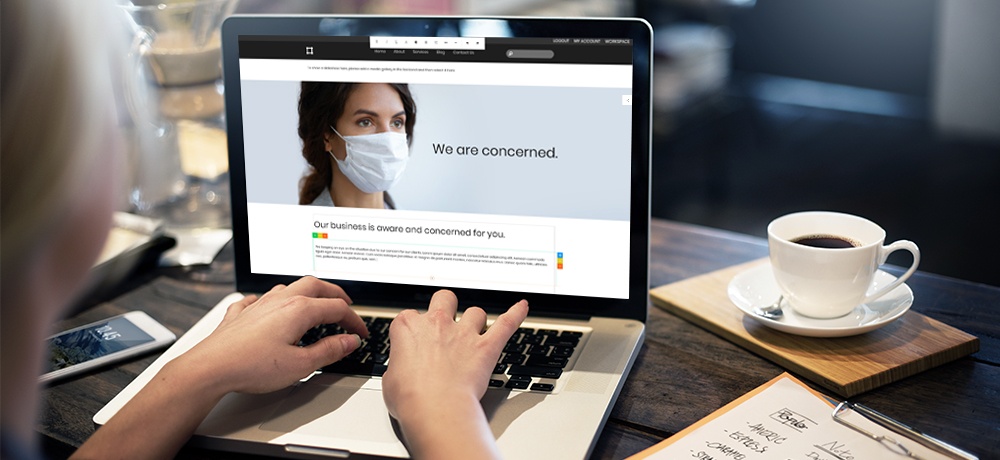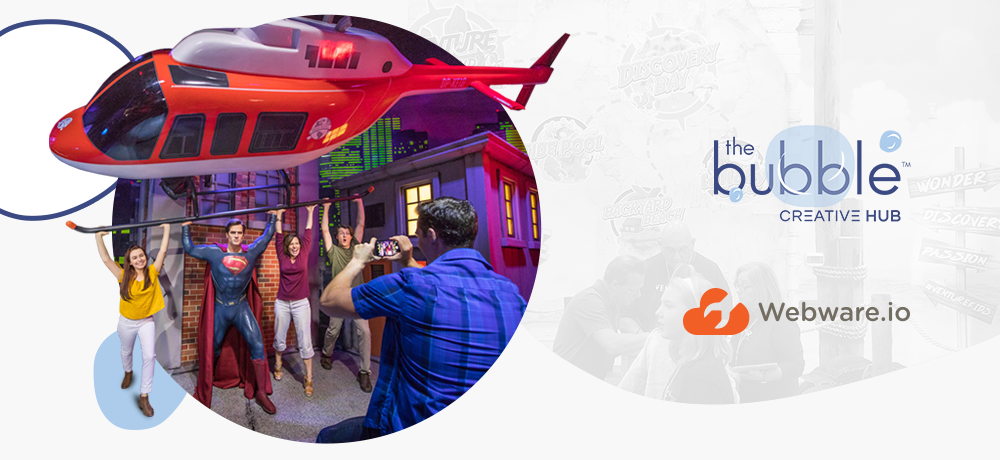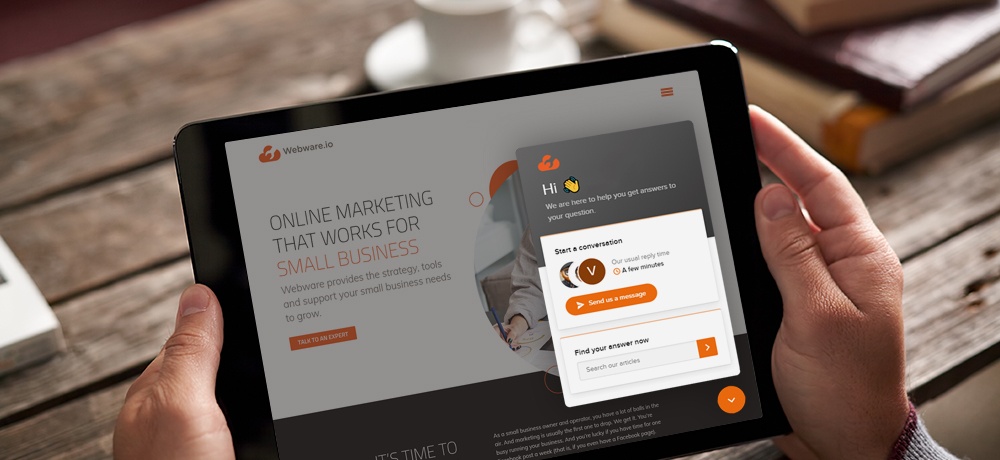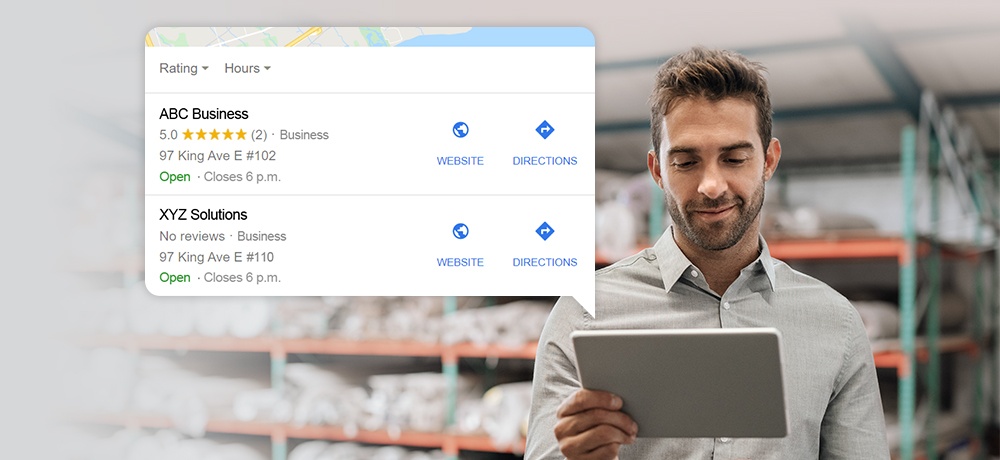6 Tips For Updating Your Website With Relevant Info During Covid-19
Updating your website during COVID-19 highlights that your business is aware and concerned. It tells your customers that you are keeping an eye on the situation due to your concern for clients. Not only does doing so help consumers get a better idea of any new policies (such as shipping changes or rescheduling) and measures you’re taking, but it also shows you in a positive light. Updating your website also shows that you have taken the appropriate measures to protect customers in case of any interactions and that you care about them enough to change policies.
Here are some tips to get you started.
1. Start with the Header, Not Just the Heading
There’s a reason the update on the CDC website catches the eye instantly: it’s because their website sports a large, attention-grabbing banner at the very top of their home page—with a big, menacing artistic interpretation of the virus. Considering current customer interest in the virus, you’ll have to do something similar. Give them visual cues before you give them textual, anecdotal consolations.
The header is a great place to start. But there’s a catch: this header shouldn’t just be a decorative piece that you use on your home page. While you probably get the most traffic re-routed to your home page, most users don’t land on this page when they come across your website. Use Google Analytics to find out which of your internal pages receives the most traffic. If we were to take a guess, we’d say that most traffic was landing on… landing pages.
After all, Google ranks pages—not websites. Here are a few tips on what to do with the header:
- Keep the text short and attention-grabbing. For instance, which of these is easier on the eyes: COVID-19 Update or SARS-CoV-2 Reparations.
- Action-oriented language works best in this case. If you’ve added too much text to your main notification, declutter and keep it simple. Something like “Follow our updates” or “Read our new shipping policy.” Don’t write a thesis.
- Create an ALERT bar—but make sure users have the option to collapse it, because it can get annoying.
- Use bold colors and block texts.
- Keep it easily customizable.
- Use high-quality, high-resolution images.
2. Make a Separate Landing Page
If your services and products have been particularly impacted—positively or negatively—just a header won’t be enough. Let’s say you sell masks and PPEs; in this case, it’s best to have a separate landing page for COVID-related products, because several visitors are bound to click through for those alone. Moreover, keep the URLs consistent for these pages.
This will help users bookmark the page, and search engine spiders will have an easier time crawling and indexing it.
3. Update the URL
If you do have a separate landing page for COVID-19 updates/products, you should really optimize its URL. Not only is this SEO-friendly, but it can also help you keep track of your content in the future. This also helps SERPs group all your blog posts together.
4. Updating Business Hours? Spread the News
Most businesses that are delivering products—and those that depend upon dispatching people working on-ground (such as plumbers)—have changed their business timings. If your business has also undergone a similar change, ensure that this is reflected not only on your website, but also on:
- All your social media pages
- All listings and local directories
Similarly, update all your logistical and scheduling details. It’s best to have a 24/7 customer service option on the side. This helps users know that you’re still here for them, 24 hours a day, despite the pandemic and all the problems it poses.
5. Keep the Content Relevant
We’re assuming that blogs and articles are a regular part of your SEO campaign. And perhaps you also do infographics and videos, which are great add-ons. We’d suggest keeping the content relevant to the times and uploading COVID-related blogs, articles, and interactive videos. Make sure your business is somehow related to what you’re putting out there—make a connection.
Use royalty free images to keep the content visually attractive. The goal is to ensure that your customers are hooked to your content. It’s even better to have a comment section below the blog posts, to encourage visitors to leave comments or start a discussion. This helps you interact with customers, relays useful information about your business, and is also useful for other onlookers who might be scrolling through.
6. Add Cashless Payment Options
If you haven’t already implemented it, having a cashless payment option on your website is imperative. E-commerce rules in the pandemic, and no matter how small a local area you operate in, it’s best to offer online orders and delivery options during this time. Ensure that your checkout process is simple, easy, and quick. Customers shouldn’t face long delays or glitches when they’re trying to order something. Send quick notifications.
And don’t forget to optimize for mobile. Most of your customers won’t just be shopping online—they’ll be doing it from their smartphones.
Article Source Credits:
Author: Joseph Dyson
Joseph Dyson is a website optimization services and SEO specialist from Search Berg. He’s been closely following the COVID-19 pandemic, especially how businesses have been impacted by it. Under his guidance, many businesses have updated their websites for the pandemic, and have seen a boost in organic traffic, CTR rates, and ROI.
Article Source: www.smallbusinessbonfire.com
Originally Posted on: Sep 24, 2020
Website of The Week
At Advanced Axis, the team offers entry-level sales & marketing job opportunities across Pennsylvania. To help them reach a wider audience, we launched their new website - www.advancedaxisinc.com
We wish the team at Advanced Axis the best of success.
Website of The Week
Fish Pot Studios is a film production company offering video & film production services to clients across New Orleans, Louisiana, Los Angeles, New York, United States, and London. To help them reach a wider audience, we launched their new website - www.fish-pot.com
We wish the team at Fish Pot Studios the best of success.
Website of The Week
Steri-Shield Expert Anti-Viral (to disinfect & protect) offers residential & commercial COVID-19 disinfection and sanitizing services across Irvine, CA. To help them reach a wider audience, we launched their new website last week - www.expertantiviral.com
We wish the team at Steri-Shield Expert Anti-Viral (to disinfect & protect) the very best of success.
Website of The Week
Fenton, Collins & You LLC The Tax Trio offers individual, business tax preparation, bookkeeping & payroll services to clients across Orem, Salt Lake City, Utah. To help the team reach a wider audience, we launched their new website last week - www.taxtrio.com
We wish everyone at Fenton, Collins & You LLC The Tax Trio the very best of success.
Website of The Week
The Bubble™ offers a wide range of creative services including vehicle wraps, banner designing, fabrication, ad specialties, augmented & virtual reality services to clients across Arlington, TX. To help them reach a wider audience, we launched their new website - www.bethebubble.com
We wish the team at The Bubble™ the best of success.
92% of US Small Businesses Have “Reinvented” Themselves During Pandemic
Bio: Michael Guta is a Staff Writer at Small Business Trends, focusing on technology and business systems. He has a B.S. in Information Communication Technology, with emphasis in Technology Management. He has used his degree to consult in the implementation of information and communications technology in developing regions. This included finding viable technologies where there is limited or no network and power infrastructures in place. He writes on tech-related subjects for publications, global companies and non-governmental organizations (NGOs).
The fact that 92% of U.S. small businesses have reinvented themselves during the pandemic says a whole lot about this bunch. Small business owners are scrappy go-getters with no quit in them. And the survey from GetApp proves that very point.
Small Business Reinventing During Pandemic
According to the survey, 92% pivoted their business in at least one way, but many have pivoted in multiple ways. This means only a small minority, or 8% didn’t pivot their business at all to adapt to the current environment.
When these businesses are pivoting, they are changing their business model on the fly. And when they do, they are hitting paydirt. One of the respondents in the survey highlights the need to quickly change a company’s business model.
Sally Matsumae, owner of Asahi Imports, a small Japanese grocery store and delicatessen in Austin, Texas, is such an entrepreneur. Matsumae goes on to say, “With shortened business hours and everyone’s fear of leaving their homes, we had to quickly figure out a way to offer online shopping and curbside services.”
Adding, “With the pandemic, we had to act fast. We had to scramble to get some sort of system that shoppers could use to tell us what items they wanted without having to step into the store.”
So, what are the five business model changes that are helping these companies survive?
The 5 Business Models
These business models are primarily being driven by digital technology. And as the survey reveals, you can use the technology no matter how small your business. The key is to adapt to the changing conditions and implement the solutions to better serve your customers.
Online Delivery Channel
Many small businesses have been thinking about launching online delivery. But before the pandemic, it wasn’t absolutely essential. This is what Matsumae also says regarding this very issue. “I’ve always wanted to have an online store, but unfortunately it was always one of those things on the to-do list.”
In the case of Matsumae, the business added an online inventory to its website along with an embedded Google Form.
According to GetApp, “Ultimately, what matters most is getting your business online—how you do it is less important.” So, look at all your options and find out the best solution for your business, customers and location. An online marketplace that lets your customers buy or order online is a must during the pandemic and beyond.
Virtual Service
Whether you are a music teacher, personal trainer, or chef, you can create virtual services to supplement your income.
In the survey two out of five small businesses are creating a new virtual service. This not only lets you keep your local customers, but you can also find new ones around the world.
Offline Delivery Channel
While an online delivery channel will keep your customers engaged, don’t forget about offline delivery. Curbside pickup and home delivery is another way to keep your business going.
If your business can’t afford its own delivery service at the moment, consider services such as Uber Eats. As the report points out, make sure to look into the cost of these services. With profit margins so low, the cost might not be worth the benefits.
On the other hand, even with razor-thin margins it can be a great way to build your customer base. And when social distancing is over, they will remember to come to your business in person.
Design a New Product
Designing a new product may not be possible for many businesses, but for those that can, it is another opportunity. Manufacturers can pivot their production to address a need in this market. Whether it is masks, sanitizers, or other PPEs, there is an opportunity.
By reconfiguring your resources to address a new need, you can keep your business going until things pick up.
Target New Customers
Targeting new customers is always a goal for any business. However, in this particular scenario finding new customers that want to buy your products is especially important. This is because businesses across the board are losing a percentage of their customer base.
While you are looking for new customers, don’t forget to try even harder to keep your existing customers. Cashflow is a big problem for small businesses, so keep that in mind as you try to find new customers.
Challenges of Pivoting
GetApp says businesses that are pivoting are three times more likely to report higher revenue. Fifty-one percent say they have increased against their forecast because of the pivots. It goes all the way down to 16% for businesses that didn’t pivot.
This, however, doesn’t mean there are not any challenges. The top challenges are lack of skills for the new approach (22%), shortage of funds (16%), and setting up new online delivery channels (14%).
When you see your business environment changing, taking action is key. Waiting for things to get better might work, but you are not in control. By pivoting to fully address the challenges head-on will keep your business going and point out new opportunities.
5 Reasons Why You Should Offer Live Chat Support for Your Website
Did you know that 83% of customers require some type of support before completing an online purchase? One way to offer customers a valuable and memorable customer service experience is by offering live chat support on your website. Installing a chat widget on your website allows your customers to open a chat box and instantly connect with your business without leaving the website. For both content and ecommerce websites, using chat to communicate with your customers in real time can be beneficial for your bottom line.
Here are 5 reasons why you should consider offering chat on your website:
1. Boost sales.
With the ability to answers questions right away, assist a customer through a purchase, or offer an on-the-spot promotion, live chat can help improve sales numbers. One study showed 44% of respondents agreed being able to use to live chat to ask questions during the ecommerce purchase was one of the most valuable features a website can have. 52% of customers will abandon an online purchase if they can’t find quick answers! Live chat allows you to step in and save a sale that’s about to be abandoned or help a customer decide between you and your competitor. Online chat also provides a great opportunity to up-sell products and ensure repeat customers 63% of respondents who chatted said they were more likely to return to the site, and 62% reported being more likely to purchase from the site again.
2. Offer better customer service.
Chat is an amazing platform to connect with your customers. Chatting in real time can help you quickly identify pain points and understand issues that may be contributing negatively to your business. When it comes to quality service, customers are looking to have their questions answered ASAP. On average, customer queries on chat are answered within 42 seconds! That’s fast! Having an FAQ guide for your customer service reps can further improve response time. In addition to quick answers, the ability to chat in real time with a customer to offer technical assistance or provide a coupon code means you can diffuse negative experiences and retain customers.
3. Online chat is convenient.
Customers now prefer live chat support to phone support. Convenience is one of its most attractive qualities; customers don’t have to leave the website to ask questions about a product or service. They don’t have to open their email or find a phone, or look you up on social media. Customers appreciate a business that values their time and they are likely to show appreciation through word of mouth advertising or repeat sales. Providing convenient service with quality information through live chat support helps strengthen your customer relationships and your business.
4. Reduce customer service expenses.
Case studies show that live chat software can reduce phone and customer support expenses. One employee can handle one phone call at a time. With online chat, the same employee could manage 4-5 chats at the same time, reducing the amount of overall customer service agents needed. Whether your customer service is handled by you or a call centre, the addition of online chat will improve the efficiency of your support team.
5. Build credibility with your customers.
Being able to chat with an employee, or better, the owner of the business, improves credibility with your customers. Using a website can feel impersonal and adding live chat adds a friendly, small business experience that customers appreciate. Ensure your team is trained and equipped with the knowledge and skills to provide a valuable customer service experience. Maintain credibility by providing customers with quick answers that are relevant and easy to understand. Once you implement online chat as a customer service option, keep regular live chat hours and respond to any offline queries right away.
Conclusion
A live chat strategically located on your website can help your business build a strong rapport with customers. Most live chat services offer the ability to chat right from your mobile so it’s easy for small business owners to stay connected. Zopim, LiveChat Inc, Olark and Intercom all offer live chat platforms for websites. Get connected with your customers and start reaping the benefits of online chat for your business today.
Webware.io provides the services, support, and expertise to help you small business navigate the online channels. To learn more about our services and how we can help maximize your businesses' exposure online, please click here.
If you have any questions about how we can help with your digital marketing needs, we’d love to hear from you. Please contact our experts here
62% of Small Businesses Fail with Facebook Ads. Here’s How to Fix That
Bio: He is the co-founder of NP Digital and Subscribers. The Wall Street Journal calls him a top influencer on the web, Forbes says he is one of the top 10 marketers, and Entrepreneur Magazine says he created one of the 100 most brilliant companies. Neil is a New York Times bestselling author and was recognized as a top 100 entrepreneur under the age of 30 by President Obama and a top 100 entrepreneur under the age of 35 by the United Nations.
Everyone is using Facebook these days. There are over 2.2 billion active daily users.
China, the largest country in the world, only contains 1.4 billion people.
The ‘population’ of Facebook is massive!
No wonder businesses all want to use it to promote their products and services.
The problem is, 62% of small businesses feel like their paid Facebook Ads are failing.
No one wants to be throwing money at ads that don’t work! What good is such a massive pool of potential customers if you can’t successfully reach them?
Thankfully, there are ways to fix this problem. You don’t have to be part of that 62%!
I’m going to show you the most common reasons why small businesses fail with Facebook Ads and how to fix each issue.
But first, let’s look at the big picture to understand the problem better.
The Problem Isn’t Facebook Ads
96% of all B2C marketers use social media posts as a form of content marketing. That leaves only 4% that don’t!
Not only that, but out of all of the B2C companies using social media, 97% of them use Facebook!
This means nearly everyone is using Facebook for business marketing.
If everyone is doing it, it must work, right?
Overall, only 3% of companies who participated in the Content Marketing Institute survey felt that their content marketing approach was not successful.
Since I just showed you that over 97% of them were using Facebook, we have to assume they included that in these results.
And that means Facebook content marketing is successful for the majority of businesses, in general.
But small business owners seem to be struggling with success.
Manta surveyed 4,712 small business owners regarding their use of Facebook, and their results are similar to Weebly’s.
50% of small businesses feel they’re not getting a positive return on investment from Facebook.
This is important for two reasons:
- The pool of potential customers is so massive, that if you cannot do this right, you’re handing over a huge chunk of business to your competitors who succeed at it.
- You’re paying for ads that aren’t providing a return, which means you’re just throwing away time and money.
Why is it that small businesses are failing at Facebook Ads when larger companies are not?
What are small businesses doing wrong?
Problem #1 – A lack of understanding of content marketing
I just showed you that the problem is small businesses and not Facebook Ads.
So what do small businesses have in common, that big businesses do not when it comes to Facebook advertising?
Let’s look at small businesses.
About one-third of small businesses fail within the first two years, and half of all small businesses fail by year five.
Why is the failure rate so high?
There is a range of reasons, from lack of experience to lack of cash flow.
Of course, these reasons for failing in business can also be valid reasons for failing in marketing.
Let’s start with the lack of experience.
Too many small business owners try to wear too many hats.
Just because you are an expert in your field, your product, or your service, does not mean you know everything you need to know about running a business.
Facebook Ads are not like an ad you pay to have in the local newspaper.
A basic understanding of content marketing is necessary to see success unless you’re just insanely lucky.
Understanding social marketing and how it differs from traditional marketing can make all the difference.
A typical approach through the sales funnel is actually a long and winding road across different channels, devices, and messages.
Your first job, then, is to try to recreate this whole winding path within Facebook Ad campaigns.
You need to have multiple campaigns, each with different objectives, and target audiences with varying levels of intent.
That means we need to look at campaigns as a whole.
Then we need to find the bottlenecks and determine how steps right before or after them are contributing to the issue.
The good news is that Facebook helps you with this right out of the gate:
Depending on your selection, your objectives and ads should be completely different.
Is your problem low sales?
Start with conversion campaigns.
Make sure all the basics are covered.
Create a ‘tripwire’ to scale down complex or expensive areas.
Focusing on being simple and straightforward should do the trick.
Are you trying to create consideration-building campaigns?
You need to actively re-engage people who are familiar with your business.
That means recapturing past visitors.
You should be using Dynamic Product Ads to see who has viewed product pages.
Focus on getting people to download eBooks, white papers, and checklists or try getting them to attend webinars.
Make sure you use marketing automation for all of this stuff to make it seamless.
Is your priority simply increasing awareness of your brand?
Prioritize expanding your reach by optimizing ads for website visits and clicks.
Aim to promote content that will appeal to the widest possible target group.
And make sure you try carousel ads to test different messaging to see what’s most effective.
Problem #2 – No strategy, plan, or measurement system
Of course, I realize it’s not as cut and dry as ‘learn content marketing and you will be a success’!
I also realize how many hats a small business owner has to wear and how limited your time can be.
So I’ll take you through several specific areas where small businesses tend to fail with Facebook Ads and how to quickly fix them today.
First off, as with any part of your business, the biggest mistake is not having a strategy and plan.
There is massive potential to grow your business using Facebook, but if you don’t have a clear vision of how you want to use it or what you want the outcome to be, you will fail.
Facebook is just another business tool. It is used by different businesses in different ways.
Over 72% of small businesses said they want to use Facebook to raise awareness.
If this is your goal, then a low click-through rate doesn’t accurately measure whether you were successful or not.
Before you try anything else, figure out what is your goal of using Facebook.
The top goals for small business owners in the Mantra study were:
- Building awareness
- Attracting new customers
- Getting phone calls from new customers
- Increasing website traffic
- Improving customer retention
Once you know your goals, then figure out how you’re going to measure success.
To make sure you’re picking the right posts, you need to establish engagement benchmarks.
This will help you decide whether or not a paid promotion will be worth it.
Keep in mind that benchmarks will vary between companies based on their goals.
To set an engagement benchmark for your company, you’ll want to look at your current number of followers, past engagement rates, competitors’ engagement, and your overall Facebook goals.
You’ll also want to determine how much value a click and conversion hold to your company. This will allow you to view your campaign in terms of monetary value and compare it with other advertising expenses.
A monetary value will also help justify the time and resources you put into Facebook Ads.
The benefits of maintaining an active presence on social media will only increase as time goes on.
Especially if you are a small company with little social media presence, a little effort will go a long way.
The best way to start is to define your goals, whether that be brand awareness or strictly conversions.
Plan a content strategy around your goals and desired brand personality.
Then, you’ll want to know who you’re talking to. Consider your current customer base and the type of audience you want to attract on social media.
Developing a deep understanding of your audience will help you create more engaging content and, therefore, create more effective paid ads.
Once your content is flowing, you’ll want to start tracking your KPIs so you can prove that your social media is successful.
Keep in mind that the average conversion rate for Facebook Ads is only 9.21%
The report also showed that the average conversion rate is highest in the fitness industry, at 14.29%, and education, at 13.58%. It’s the lowest in the technology sector, at 2.31%.
If you’re expecting Facebook Ads to provide a 50% conversion rate, of course, you will feel like they’re failing!
That being said, Facebook does produce the best ROI of all social media platforms.
How do you know your plan is working?
Test it. Continuously.
You need to test different offers to understand what works and adjust your plan accordingly.
The problem with the standard recommended A/B tests is that most fail.
To make matters worse, they’re incredibly hard to get results from if you’re not already converting well.
You shouldn’t even bother with A/B tests if you don’t yet have at least 1,000 monthly conversions.
Any single test should have a minimum of 250 conversions before you can believe the sample size.
The companies with the highest conversions aren’t even testing variables (which is what most A/B tests do).
Instead, they’re testing different offers.
That could mean one e-book but on completely different topics.
Both topics should be top of the funnel topics that appeal to a variety of people.
Both can also apply to the same segment or target group such as startup founders.
The only way to know which one converts best is to roll the dice and see.
That’s why planning without checking the results can mean failure.
Problem #3 – You’re not investing enough time.
58% of small businesses are only spending an hour a week on their Facebook marketing efforts.
Why is this a problem?
Because 3.3 million items are shared on Facebook every minute!
If you’re only active on Facebook infrequently, then your ads will never be seen among all the other noise.
There is simply too much volume.
Social Media Examiner surveyed social media marketers and found out that on average, they post on a branded Facebook page 8 times per day.
Imagine how quickly your ads are getting lost in news feeds if you only post once per day.
According to Mantra, an hour a day is even more time than most small businesses are investing!
The same survey indicated that 58% of small business owners put less than an hour a week into Facebook marketing.
Social media can’t be an afterthought. You will fail if you think of it this way.
As of March 2017,almost two billion people are monthly active Facebook users. Chances are most of your target customers are among those billions of people.
39% of marketers have increased their posting frequency on Facebook over the last 12 months.
If you only post infrequently, your potential customers likely won’t even see your posts.
According to Post Planner’s research, 75% of the engagement you get on your posts happens within the first 5 hours.
After that, engagement pretty much dies off.
This means if you aren’t posting regularly, you’re basically history.
While there are roughly 60 million businesses using Facebook pages, only about 4 million of those are actively posting on their page.
A stale business page could actually hurt your business more than no business page!
Anyone who comes across your out-of-date page may wonder if you’re still open or even a real business.
Facebook is the kind of thing that needs to be done right or not done at all.
Be honest with yourself about the time and resources you are willing to commit to your company’s Facebook page.
I should also warn that it is possible to go too far in the other direction as well.
Posting too much will overwhelm people with your messages to the point where they start tuning you out.
What’s the right frequency? Aim for 3 to 8 ad appearances per person over the life of your ad.
This can help make sure that your ads don’t become white noise.
Avoid setups like this one:
A frequency of 38 won’t just make people tune you out. It could turn potential customers into haters!
Problem #4 – You’re not investing enough money
Going back to the Weebly survey of small business owners, 82% have spent less than $50 on a Facebook Ad campaign and more than half didn’t buy Facebook Ads at all.
Less than $50!
In comparison, most successful B2C marketers spent an average of 26% of their entire marketing budget on content marketing (including Facebook Ads).
I can guarantee you this was more than $50!
Not only that, but 37% of them plan on increasing that spend over the next year.
But most small business owners surveyed by Weebly don’t want to spend any money on a paid campaign.
I get it. It can be hard to throw money at ads when you don’t know if they’ll work.
The good news is that you can experiment with organic posts to understand what resonates best with your audience before spending any money.
Look at the engagement of your current social media posts. If you have a post that’s creating a lot of organic engagement, it may be a good post to turn into a paid ad.
It will have a much better chance of success.
All ads on Facebook are basically just regular posts. The only difference is that you’re paying Facebook to maximize your reach.
Only a tiny fraction of followers will see your regular posts.
The reach of organic posts has been steadily declining as Facebook updates their algorithm.
Regular posts also don’t give you the ability to target specific people who are more likely to click on them.
When using paid advertising, you can target the people who are likely to be interested in your brand based off interests that they have expressed in the past and other data that Facebook has collected.
Today, reliance on free, organic results on Facebook will doom you to failure.
Organic posts reach only about 2% of your fans!
This means that 98% of your Facebook page’s fans may not see your posts.
That’s a huge loss of traffic!
Not to mention that the 2% you’re reaching are people who are already your fans!
Good luck reaching new audiences organically.
The situation is slightly better for smaller brands, but it’s still only about 6% of your fans that you will reach with organic content.
Let’s face it, social media for businesses has changed. It’s now a pay to play arena.
If you are trying to reach a wider audience with your Facebook posts, you’ll need to use Promoted Posts and other advanced Facebook Ad strategies.
Problem #5 – You’re not targeting the right audience
It’s not that small businesses contacted by Weebly weren’t seeing any returns on their ads.
It’s the quality of the returns that seem to be in question.
According to the feedback, small business owners did get clicks and likes but struggled with sales conversions.
“Although I may get clicks or likes, it doesn’t always translate to more money coming through the door,” one owner says.
Putting it simply, another responds, “Lots of impressions but almost no conversion.”
“When businesses don’t see the results they hope for, it’s usually because they haven’t done enough testing of their ad copy, visuals, and the ideal combination to target the right audience,” says Vitruvian Digital Advertising founder Kristie McDonald.
The potential audience on Facebook is massive.
Only a small percentage of them will actually convert
Small businesses aren’t asking themselves the right questions to determine an effective target market for Facebook Ads.
Have you been guilty of only defining your audience by their gender, age, and income?
If you’re choosing the simplest of criteria to let Facebook know your target audience, you’re going to fail.
You need to use more powerful insights into the behaviors and unique interests of your ideal audience.
That way you can deliver your ads only to people most likely to want what you have to offer.
Make sure you don’t just combine your demographics with every interest and behavior you can think of.
You need to set the criteria for only one or two interests and behaviors at a time.
If you try to go too wide, you will just spend a lot of money on audiences that don’t convert well.
You need to get laser specific in telling Facebook who you want to show your ads.
Make sure you’re targeting custom interest and lookalike audiences.
Use a social listening tool to monitor updates and sentiment.
This will tell you if what customers mean matches what they are saying.
Sometimes what they tell you is most important to them isn’t actually the most important thing.
You can use social listening to divide the market by interests instead of the typical demographic data.
Listening also allows for better personalization of ad content.
This is really valuable since 71% of consumers prefer personalized ads.
Whether you are relying on organic and paid advertising, the personalization of your brand is what will set you apart in the long run.
Once you know who you’re trying to reach, you can work on the type of content that will resonate with each segment.
Make sure that you use your value proposition to set your product or offer apart from the competition.
Remember that the value proposition needs to be phrased and marketed differently for audiences in each stage of the funnel.
Use your ads to get the right message to the right audience instead of trying to blast everyone with one message.
How do you know you successfully hit the right audience with the right message?
Facebook has a Relevance Score that will tell you.
The better you are at targeting the right ad message to the right audience, the better your click-through rate will be and the lower your cost per click.
AdEspresso decided to test this measure. They discovered that when they ran the exact same ad, but with better targeting, it got a much better Relevance Score.
Not only that, it dropped their cost per click and gained them four times more clicks when compared with the poorly targeted ad.
You can find this metric by going to one of your ad campaigns, going down to a specific Ad Set, and then looking in the lower right-hand corner.
The scoring system is one to ten, with one being the worst and ten the best.
Problem #6 – Stop trying to go for the cold sale
This is some of the feedback from one of the survey respondents who told Weebly that Facebook Ads don’t work:
We very rarely have ever gotten sales through Facebook. We feel that ‘Friends’ on Facebook would rather interact than be sold to. Trying to sell via Facebook is like walking around at a party and passing out business cards trying to sell your products to friends who would rather be socializing than dealing with a sales attempt.
It sounds to me like this person was trying to hard sell on a cold audience.
Socializing is the new way of selling.
If you only plan on pushing cold sales on social media, you might as well forget Facebook. At least that’s what Emily Pope, a small business marketing expert from Fundera thinks.
A good Facebook page strategy consists of a healthy mix of feel-good content, information your customers need to know, and a small bit of advertising. If you’re not set up for that or want to focus only on hard selling numbers, you’ll be wasting your time on a Facebook page.
In other words, you want to focus on benefitting and giving content to your consumers before asking them for anything, especially a sale.
To get the most out of Facebook, engage with your online community in positive ways.
How can you fix this?
Remember the sales funnel.
You need to build the relationship from the beginning on the funnel.
My guess is that this business owner isn’t used to coaxing customers through the funnel.
If you’re only used to selling to people once they walk into your store, you’re used to the hard sell strategy that works on people ready to buy.
This means you’re missing out on huge sales opportunities, even outside of Facebook!
On social media, you need to build trust before you can push a sale.
This isn’t something you can do with the occasional monthly post (see problem #3).
One quick way around it is to build a working relationship with influencers in your market.
Facebook works extremely well for retargeting.
This is one of the best values of Facebook Ads.
Why?
This audience is four times more likely to convert!
One reason for this is that these customers are already familiar with your brand and your product.
It’s no longer a cold sell.
No one is hanging out on Facebook looking to make a purchase.
Refer back to problem #1. You’re going to need to build multiple ad campaigns, one for each stage of the sales funnel.
Otherwise, you’re not going to be able to compete with all of the reasons they logged into Facebook.
Stop trying to jump right into the sales pitch!
Problem #7 – Understand that Facebook is a business
Some of the small business owners surveyed said they don’t believe the promise that paid posts will reach a larger audience.
Small business owners seem to begin to distrust Facebook right at the very beginning of an Ad campaign before there’s even been time to see results.
When the ad order is placed, most small business owners reached by Weebly were left saying, “Show me people. Where are the people? There are no people!”
You need to remember that Facebook is a business.
While it may seem like just a free place to hang out and socialize, it’s not.
You need to treat your relationship with Facebook the same as you would any business partnership.
You will only get a return out of it if you invest in it.
For example, linking a Facebook Pixel to your e-commerce site can have huge benefits for you.
Facebook also loves this because it provides them with tons of audience data.
If you see Facebook as anything other than a business, I’m betting you’re too uncomfortable to link all of your site data to them.
But as a business, if you don’t provide profit to them in some way (either information or money), then they have no incentive to help you succeed.
Facebook has proven results. They’re old in the social marketing world.
This is not some new kid on the block who is still untested.
The list of brands who’ve been successful with Facebook Ads goes on and on.
Facebook has an entire database of successful case studies.
Those results aren’t just for big business either.
Check out this ad for Design Pickle, (a startup):
Design Pickle offers unlimited graphics requests.
This ad is directly responsible for almost $6,000 in monthly recurring revenue for Design Pickle.
How?
They used it to target highly qualified leads. Leads who they then sent this survey:
They chose so many questions on purpose.
They used it to weed out people who were just looking for a freebie.
That meant they only got leads which were more likely to convert.
Their campaign generated around 500 leads.
30 of those leads turned into subscribers of their $200 per month service.
They estimate that their customer lifetime value to be around $1,100.
This means the one Facebook Ad resulted in an amazing 633% ROI!
If you want Facebook to work like this for you, you will have to change your viewpoint.
Treat it like a business and be willing to invest time, money, and some of your company and customer data to get an amazing return.
Conclusion
Almost two-thirds of small businesses are failing with Facebook Ads. You don’t have to be one of them!
Remember that Facebook Ads work.
There are proven results that work for companies of all sizes, and the huge majority of businesses use them for content marketing.
The problem is not with Facebook.
It’s with how you’re approaching Facebook.
Treat it like a business partnership.
Make a strategy, determine what you want out of it and how you’re going to measure your return.
Be prepared to invest more time and money into it if you want results.
As long as you invest wisely, targeting the right audiences with the right messages, you will see a positive ROI.
Facebook wasn’t designed as a place to cold-sell customers.
It is social media. Be social. Build relationships. Connect with influencers and your audience.
Those relationships can still be profitable!
What has been your biggest challenge with Facebook Ads?
Five Ways to Boost Your SEO Strategy and Online Presence
As more businesses understand the necessity of being online, getting noticed has become the new challenge. If you’ve recently launched your website, you’ve probably experienced the same struggle. Besides the competition online, search engines like Google control what users see. Their algorithms ensure that only the most relevant pages are shown to users based on the search query and keywords used.
To optimize your website for Google’s algorithms and boost your online visibility & presence, you may be familiar with search engine optimization (SEO). SEO involves a set of best practices that help search engines recognize your content and its relevance to specific search queries. The more relevant your content is to a search, and the more prominent your online presence is, the higher your ranking will be on Google.
Google and other search engines change their search algorithms regularly and improve search result quality. As a result, your SEO and content strategy must stay top of mind to make sure you match their ranking criteria.
Below are tips to boost your online visibility and help you stay up-to-date on the latest SEO best practices to improve search rankings.
1. Update website content.
The number one driver behind your Google ranking is quality content. In order to boost your search rankings to get on the first page, it’s essential to improve your content with targeted keywords. (A combination of words people use in their search queries.) It is important to take time to research the best keywords for your business before adding them to pages throughout your website. You can then analyze your website to see which keywords get you the most traffic. These keywords will be the ones you want to focus on and research different variations of them that can be added to new pages you create for your site. Pages that each target their own keyword will give you the best results.
While creating new content for your website, make sure to avoid using excessive keywords, known as keyword stuffing, as Google could penalize your site. Adding genuine content that’s helpful to visitors can improve your site’s authority and relevance. Regularly updated content is an indicator of relevancy and shows that your website is trying to improve the user experience.
2. Get listed in website directories.
Another way to improve your ranking is to leverage the popularity of online directories and review sites like Google My Business. Your business listings help people learn more about your business, it's location and other important information. The website directory does more than a basic listing by allowing people to review and rate companies based on their experience. Besides reviews, there are more details that the Google directory puts on display. For example, when searching for CPAs in Toronto, Ontario, the Google results display a list of CPAs registered with Google My Business. These listings include reviews, addresses, contact details, hours operation, and a link to each business website. This lets people find your business quickly, easily understand what you do, and communicate with you instantly.
Listing on other directories like Yelp, Angie’s List, and Whitepages works a bit differently. These directories can be listed in search results and, when clicked, can show people multiple businesses in your industry when they search for businesses like yours.
3. Blog about what matters.
Blogs are a great way to help your business stay relevant online and boost your search rankings. They let you share your thoughts on key topics related to your business while also giving you the flexibility to use strategic keywords that relate to each one.
The only challenge with blogging is selecting topics that provide content that is both informative and interesting. With the right topic, you can inspire your readers and become a go-to resource for your audience.
Most readers who are looking for content online are not just looking for content that is unique. They’re looking for content that will help them grow both professionally and personally. To make your content unique, your blogs should contain actionable information that your readers can put to use and will benefit them. The way you present your content matters too. Long-form content helps increase your search rankings more than short-form content as long as you share valuable, concise, and straightforward information. Creating long-form content that is not focused will negate any advantages and increase your bounce rate. At the end of the day, you want to create content that captivates your audience, keeps their interest, and encourages them to continue their journey with you.
4. Collect reviews from clients.
People need assurance that they are making the right choices when purchasing products and services. A company's online reputation and reviews play a significant part in this. Similarly, online reviews help search engines understand the authority and trustworthiness of a website to ensure they provide users with the best possible results. Client reviews help improve a business' credibility and give future customers more reasons to work with you.
5. Understand website reports.
Website reports help you understand everything that is happening on your website. These reports help you see which pages are getting the most traffic, which keywords are working best, which blog posts are most engaging, and how people are finding your website. All of these details are crucial in helping you see how you can improve your SEO strategy. They indicate what kind of content your audience enjoys, which topics they are most interested in, and what platforms your audience uses to learn more about you. This is powerful information that can help you test new content strategies, develop new Ad campaigns, and create other online promotions that help bring in more traffic to your website.
Setting up your SEO strategy
Now that you have a better understanding of how SEO works, it’s time to put these tools into practice and start driving more qualified leads to your website. However, to use SEO effectively and continue boosting your online visibility, you must stay up-to-date on the latest trends. Search engine optimization is a continuous process, irrespective of the methods you use. That means you must regularly dedicate time towards your SEO strategy. To learn more about how to drive success through your SEO campaigns, please read our previous blog by clicking here.
The only thing that will hamper your online presence is failing to dedicate time to nurturing your digital growth. Don't let this happen to you. Reach out to Webware.io for all of your SEO and digital marketing needs to continue growing your business and your online presence. We are dedicated to helping you achieve your digital goals. Our all-in-one digital marketing toolkit helps you efficiently manage your website, blog, SEO, online reviews, reputation, and more!
Our services, support, and expertise help small businesses like yours easily navigate the digital world so you can focus on what you do best.
To learn more about our services at Webware.io, please click here. If you have any questions about how we can help with your digital marketing needs, we’d love to hear from you. Please contact our experts here.
Small Business Marketing Essentials: Reach More Customers With a Strong Online Presence
Exposing your small business to the online community means more than just setting up a website with your business address and contact information. It means creating a virtual version of your business, with an attractive, informative website and a social media presence. In this digital era, people use online search engines for almost everything they need. For many, Google search is the first place they go when they have a question or want to know more about something. Given the reliance on the internet today, not maintaining an active online presence can be potentially fatal for small businesses. If you are wondering how to get online, or how to take your business online, this post will explain why and how to establish a strong online presence.
Why Your Small Business Needs a Strong Online Presence:
- Visibility & Accessibility - Customers are more likely to turn to the web for research when they need information. They may either be looking for specific information on your business, services/products your business offers, or general information about your industry. Going online will give you the upper hand over your competition. The easier it is for your potential customers to find you, the more likely they will invest in your products and services.
- Build trust & confidence - A quality website, active social media, and an updated blog immediately give your business credibility to potential customers. It reassures clients that your business is established and trust-worthy. Open communication and quality customer service, through your website or social media, can help increase customer confidence and brand loyalty.
- Marketing & Ecommerce - In this new online era, the internet allows you to market to anyone, anywhere in the world. There are a number of online marketing and advertising avenues which can help extend your reach and increase both online and offline sales. Whether you’re displaying testimonials from clients or photos of your newest products, it’s never been easier to show the world what your business offers. Displaying your products or services on your website allows customers to easily learn about what your business offers.
How to Establish a Strong Online Presence:
- Website - A website serves a primary source of information about your business. The importance of local search is growing as we evolve. Most customers access the Internet, and use search engines to research everything, from entertainment to professional services. Having a website is the first step to interacting with your existing customers and attracting new customers to your business. Building an attractive, easily navigable website is a great first step to securing your online presence.
- Blog - Blogging significantly increases SEO and lands your business higher in Google search results. The more quality content on your website and the more often that content is updated, the more Google will favour your website over others. This is easily achievable with consistent, quality blog posts, relevant to your industry and business. A blog can also help establish your business as knowledgable and a go-to source of information for customers.
- Social presence - Having your small business on recognized online platforms like Facebook, Twitter, and Pinterest is essential in expanding your client base. Through these platforms, customers can learn more about you and your business. Webware offers its customers a Facebook Store, where a business can sell products directly from the business Facebook page. All your social platforms should display your expertise in your industry and maintain open communication with your customers.
- Webstore - If your business sells products, adding ecommerce to your website can increase your visibility online. Online shopping is a growing force in the retail market and can help you reach a new customer base, outside your local area.
- Reviews - People often check reviews to help them decide between products or services. People generally trust their peers so good online reviews can be a gold-mine for your business. Reviews also help increase your business’s ranking on the Google Search Results page. Again, the more quality content that links back to your website, the more Google will favour it. Install a Review widget (like Yotpo) on your website and encourage customers to write reviews about your products and their experience with your business.
The Bottom Line
In today’s Internet-focused world, a business that doesn’t maintain an active online presence will go unnoticed by Google and potential customers. To avoid being lost in the internet clutter, ensure your business is easily accessible both locally and across the globe.
Your website and social media presence are opportunities to make a great first impression. Inspire trust and confidence in your clients from day one with a well designed and comprehensive digital strategy.
If this blog has you considering how you can improve your online presence, maybe it’s time for you to find a digital marketing solution that fits your business. Webware.io is a digital marketing agency that provides the services, support and expertise to help you stay competitive in today’s web-based world. We work with you to provide website design services, e-commerce solutions, blogging, email newsletter management, social media marketing, reputation management, and more.
To learn more about our services, please click here. If you have any questions about how we can help you or digital marketing, we’d love to hear from you. Please contact us here.
Don't believe these myths when marketing your small business online
Have you considered online marketing for your small business? If you have a website, online marketing is a great way to increase traffic, leads and sales. Online Marketing covers a range of business-boosting activities: SEO (Search Engine Optimization) social media marketing (Facebook, YouTube, Twitter, Instagram etc), content marketing, email marketing, paid advertising to name a few. If you’re not sure if online marketing will work for your business, here’s 6 online marketing myths debunked to get you on your way!
Myth #1 My Business Doesn’t Need an Online Presence.
Perhaps you feel that your customers aren’t online (they are!), or maybe you don’t need more customers at the moment. While that’s a nice, comfy position to be in, it may not last forever. Even if your business is in a good spot today, an online presence can help solidify its future. The majority of the North American population use the internet from all age groups: over 90% usage rate for ages 18-50, over 80% usage for ages 50-64 and almost 60% usage rate for over 65 years. For many of these internet users, heading to Google search is the first thing they do when they’re looking for more information. If your business is online, your potential customers have a much better chance of finding you! An online presence increases your business’s visibility and accessibility while building trust and confidence with your customers. In today’s digital age, it is no longer a luxury to be online - your customers expect it! Read more about why your business needs a strong online presence here.
Myth #2 I Don’t Have Money For Online Marketing.
Spending money on online marketing is an investment in your business’s future. Once you find the right online marketing strategy that works for your business, you will see an increase in traffic, and leads. You might be surprised at the results even a small online marketing budget can yield. Start small and use analytics to find what works - you’ll be glad you did! Even the most limited budget can benefit from Google’s tools to help your business communicate up-to-date business info, manage reviews and connect social media accounts to boost search engine results.
Myth #3 Online Marketing Doesn’t Work.
Perhaps you’ve had a sour experience, received some bad advice, or didn’t give the online marketing strategy enough time to work. While it’s true that not every type of online marketing works for all businesses, there is a strategy that will work for you. If online marketing hasn’t worked for you in the past, or you’re skeptical of it altogether, Google is a trusted and safe place to start. Google is continuously improving its search algorithms so it’s easier for your customers to find you - making online marketing easier for small business. Learn more about how Google can help your business here.
Finding an online marketing strategy that works for your business starts with market research. Get to know where your customers and target audience spend time online; focus your efforts on those channels. Once you know WHERE to market online, creating quality content is more important than quantity. Understand who your customers are and tailor your content to their interests and needs. If you plan to hire an agency to help you, check reviews, ask specific questions about what methods they use and what kind of results to expect.
Myth #4 - I can expect results right away!
As they embark on an online marketing journey, many businesses have the expectation that they will see results right away. Unfortunately, gaining solid SEO (Search Engine Optimization) ground is mostly about building strength over time (for example - with keywords, link building, blogging etc). A quality, online marketing strategy that includes SEO will likely yield results starting at the 6 month mark. It’s common to see small results as early as 3 months but investing a minimum of 12 months into an online marketing strategy is your best bet. Once you’re happy with how your strategy is performing, implement a maintenance strategy to keep up the momentum. Don’t let minimal results in the beginning discourage you; online marketing is a marathon - not a sprint!
Myth #5- My business doesn’t need a website; we are on Facebook, Twitter, LinkedIn, Instagram!
Social Media Marketing is only one part of a comprehensive online marketing strategy. While using the same social networks your customers use is extremely important, they don’t take the place of a website. Even though your social media profiles will show up on Google searches, they are not contributing to your SEO ranking. Additionally, social media platforms are likely to change over time; websites aren’t going anywhere. It’s hard to imagine platforms like FaceBook and Twitter becoming irrelevant, but MySpace is a great reminder that it can happen. Lastly, your website and the content within it, are owned by you. Facebook owns your business page (and its content) and can choose to shut it down at any time. For the best chance at online marketing success, be sure to include a range of proven marketing tactics, like a website, in addition to your social media campaigns.
Myth #6 - There’s too much competition; there’s no point in online marketing.
If your competition includes a lot of big companies with huge marketing budgets, it can be difficult to increase your search ranking for certain keywords. However, that doesn’t mean you can’t find a strategy that works for your business. Even if you aren’t competing with Fortune500 companies for search engine rankings, here’s 3 ways to step ahead of your competition:
- Long-tail keyword strategy. A long-tail keyword is a specific, detailed phrase (usually contains more than 3 words) to narrow search results. For example, “where to buy conflict free diamonds online” is a long-tail keyword option for “diamond”.
- Great content marketing. As an expert in your industry with hands-on experience, you have the opportunity to provide valuable information to those looking for it. Get blogging!
- Local Search. Small businesses can leverage the power of local search by incorporating the neighbourhood or city into their SEO strategy. For example, “best fish tacos in The Distillery District, Toronto”.
People are using search in a more conversational way than ever before. Small businesses can use their unique expertise and experience to employ these strategies to get ahead of big competition.
Finding the right mix of online marketing activities to suit your small business can positively affect your bottom line. Don’t let these 6 online marketing myths discourage you from finding success!
If this article has you thinking about how you can improve your digital strategy, maybe it’s time that you consulted a professional for a digital marketing solution for your business. Webware.io is a digital marketing agency that provides the services, support, and expertise you need to stay competitive in today’s web-based world. We work with you to provide website design, e-commerce solutions, blogging, email newsletter management, social media marketing, reputation management, and more.
To learn more about our services, please click here. If you have any questions about how we can help you or digital marketing, we’d love to hear from you. Please contact us here.
The all-in-one platform that gives your business a web presence you're proud of without the headache you’re used to.













